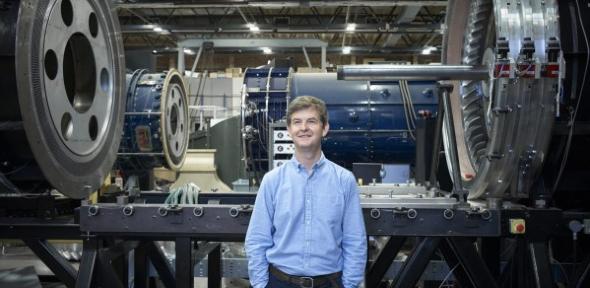
A carbon-neutral economy in 50 years? Maybe. But what if we were to go faster? Professor Rob Miller says that it is time to completely rethink the schedule.
How long will it take to make zero-carbon flight a reality? Thirty years? Longer? “Climate change means that we just don’t have that timescale,” says Professor Rob Miller. “I believe that this timescale can be cut in half and that we can have net-zero-carbon flight by 2035. But this can only become a reality if we radically change the way we develop and scale technologies”.
Thirty years ago, Professor Miller could not have imagined the challenge that he and colleagues at the Whittle Laboratory would now be taking on. Back then, he was a maths-obsessed student from South Cheshire College – an FE college not particularly known for Oxbridge applications. The youthful Miller, taking a characteristically can-do approach, decided to write directly to Professor Roger Ainsworth, a distinguished engineer and lecturer at St Catherine’s, Oxford. To his delight, Ainsworth wrote back, inviting Miller to visit him.
“I remember walking around the gardens as he talked about his love of applying maths to real world problems,” says Miller, now Chair in Aerothermal Technology and Director of the Whittle Laboratory. “He told me that he’d love me to apply, so, of course, I did – and I got in.” Rob Miller spent a summer working with Professor Ainsworth on a project for Rolls-Royce – sparking a lifelong relationship with the company, and a lifetime’s passion.
And so he has. Rob Miller has also worked with Mitsubishi Heavy Industries, Siemens and Dyson. He holds 11 patents and has experienced first-hand the excitement of seeing work that started in the Whittle Laboratory roll off the production line. Take the Rolls-Royce’s Trent 1000 engine for Boeing’s 787. While spending a summer holiday in Rolls-Royce design office, Miller looked at whether the shape of the leading edge – the first 0.5mm – of each of the necessary 6,000 compressor blades could be improved. At the time, these blades were hand-finished on the production line and could not be precisely manufactured. Miller’s computer modelling showed that this could result in a 20-30% reduction in the loss of performance – a finding that was backed up by tests in the Whittle Laboratory. The change explored and implemented by Rolls Rotce teams in blade leading-edge geometry is now estimated to save $170m of fuel burn and 540,000 tonnes of CO2 a year.
That change was only possible with everyone working together. Academics couldn’t do it alone, industry couldn’t do it alone, manufacturers couldn’t do it alone. It’s the combination that is so powerful.
Professor Rob Miller, Whittle Laboratory, Department of Engineering, University of Cambridge
With lessons learnt, the career journey has made Professor Mlller acutely aware of the time pressures imposed by climate change and the need to reach net-zero carbon by 2050. The challenge in expediting rapid-technology development to a wider range is in scale of problems and other industries. “To achieve this, we aim to build a new Whittle Laboratory and a National Centre for Propulsion and Power,” says Miller. The National Centre will have a uniquely flexible facility, lowering the barrier of entry for industry to work in the lab. “This is important because the cost and time required for people to work in aerospace research and development is high, and this means that only large companies are able to do it,” argues Miller. “The new Whittle will allow us to co-locate more multidisciplinary industry and academic teams to exploit the rapid-technology development process.” The New Whittle Laboratory intends to provide the space, the collaborations and with co-location multidisciplinary industry and academic teams.
To achieve this, we aim to build a new Whittle Laboratory and a National Centre for Propulsion and Power. It will allow us to co-locate more multidisciplinary industry and academic teams to exploit the rapid-technology development process.
To decarbonise flight and power generation, the culture and the tools currently used will need to be dramatically changed. Industry and academic collaboration is essential and is the cornerstone of the Whittle Laboratory’s historic success.
Read about plans for the National Centre for Propulsion and Power and Professor Miller’s work.
Read the full Department of Engineering, University of Cambridge article here.

